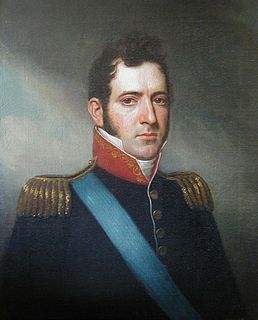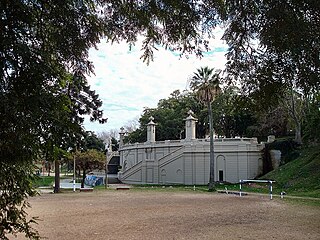The Zone of "Mangangá"
The origin of the name "Manga" is believed to come from the short name of the word "Mangangá", name which appeared mentioned in 1780, the zone later called "Manga". According to Benito Tesore, expert in Manga's history and its men that subsisted in the zone in the first years of the century. Lot of trenches and strongholds were built, possibly to stop the Portuguese advance (in Artigas' times). Armed with this assumption, it could be why municipal authority gave names as "Trinchera" (Trenches) and "Fortín" (Fort) to two roads of the zone.
The first owner of a ranch in Manga was Esteban Artigas (Son of the captain Juan Antonio Artigas), ceded by The Government of Spain. In the Register Aldecoa, from 1772-1773, he's figured as living with his six under-age children in The Manga, then known as "Pago del Arroyo de Sierra" (Zone of the brook of Mountain Range), known by that name because of a neighbour's surname of the zone.
The farm "Mangafue"-it was called that way- was passing along years by different owners, one of them, Marcos Drapple, who, in February 1834, was offerin for sale to a Salting House called "Los Dos Hermanos" (The Two Brothers), located 3 ½ miles from Montevideo. The edification consisted of two buildings, one of sixteen rooms, a store, a slaughter, a "barn raised" for storing hides, tallow, wool and grains, and a large warehouse with eaves to desalinate; the other one with a wooden trellis to stack the meat, with four doors of ventilation and a stable.
According to "El Universal", it had good grazing lands and water, willow trees and quinces, and fencing to protect ten pitas acres of crops. In the grounds of Manga, put up for sale in January 1834, there were also two flourmills, a bricked oven with a pond and a footrest. The purchaser was Lus Fernández, and with his brother José, had been linked to the place for their activities, where they had been the late eighteenth century, a farm, grocery store and flourmill. Ownership of the farm was kept by Luis Fernandez after the death of José in 1819, inherited by Manuel Cifuentes, prestigious person in Cordón, where he was justice of the peace. In 1832, Cifuentes was designated by the Economic Administrative Board of the Department of Montevideo to integrate the Public Education Committee of Extramural, together with Matías Tort and Pedro Pablo de la Sierra. In the period 1839-1841 he was a member of that such Board and years later, in 1863, after having resided in the Manga with his family during so-called Guerra Grande (Great War), he was invited to join the communal body as a backup to Félix Buxareo.

Montevideo is the capital and largest city of Uruguay. According to the 2011 census, the city proper has a population of 1,319,108 in an area of 201 square kilometres (78 sq mi). The southernmost capital city in the Americas, Montevideo is situated on the southern coast of the country, on the northeastern bank of the Río de la Plata.

José Gervasio Artigas Arnal is a national hero of Uruguay, sometimes called "the father of Uruguayan nationhood".

Manuel Ceferino Oribe y Viana was the 2nd Constitutional president of Uruguay.

Carlos María de Alvear, was an Argentine soldier and statesman, Supreme Director of the United Provinces of the Río de la Plata in 1815.

Artigas Department is the northernmost department of Uruguay, located in its northwestern region. Its capital is the city of Artigas, which borders on the Brazilian city of Quaraí. Artigas Department has an area of 11,928 square kilometres (4,605 sq mi), making it the fifth largest in the country. The population is 73,378 inhabitants, according to the 2011 census.

Minas is the capital of the Lavalleja Department in Uruguay. As of the census of 2011, it is the twelfth-most populated city in the country.

Salto is the capital city of the Salto Department in northwestern Uruguay. As of the 2011 census it had a population of 104,028 and is the second most populated city in Uruguay.

Brazo Oriental is a barrio of Montevideo, the capital of Uruguay. Brazo Oriental is a residential zone located approximately 5 kilometres (3.1 mi) from Montevideo's centre.

Centro is the inner city barrio of Montevideo, Uruguay. Its main avenue is 18 de Julio Avenue. It is delimited by La Paz Str. to the North, Florida Str. and Andes Str. to the West, Canelones Str. to the South and Barrios Amorin Str. to the East. It used to be the main commercial venue of the city, but after the opening of the first malls, many small stores started closing down. Now, that process is being reverted and the area is coming back to life.

The Rambla of Montevideo is an avenue that goes all along the coastline of Montevideo, Uruguay, and also the longest continuous sidewalk in the world. At a length of over 22.2 uninterrupted kilometres (13.7 mi), the promenade runs along the Río de la Plata and continues down the entire coast of Montevideo. Since all the southern departments of Uruguay are against either the Río de la Plata or the Atlantic Ocean, they all have ramblas as well. The Rambla is an integral part of Montevidean identity and has been proposed as a World Heritage site.

Manuel de Sarratea,, was an Argentine diplomat, politician and soldier. He was the son of Martin de Sarratea (1743–1813), of the richest merchant of Buenos-Aires and Tomasa Josefa de Altolaguirre. His sister Martina de Sarrateas (1772–1805) married Santiago de Liniers, vice-roy del Rio de la Plata.

Juan Manuel Blanes was a noted Uruguayan painter of the Realist school.

Parque Batlle, formerly Parque de los Aliados, is a barrio and a major public central park in Montevideo, Uruguay. It is named in honour of José Batlle y Ordóñez, President of Uruguay from 1903-1907 and 1911–1915.

Cordón is a central barrio of Montevideo, Uruguay, located directly East of the Centro. Its main avenue is 18 de Julio Avenue. It is delimited by Miguelete Str. and La Paz Str. to the North, Dr. Barrios Amorin Str. to the West, Canelones Str. to the South and Dr. Joaquin Requena Str., and Rivera & Artigas Avenues to the East.

Capurro is a barrio of Montevideo, Uruguay, and part of the Capurro–Bella Vista composite barrio, with Artigas Boulevard separating the two.

Bella Vista is a barrio of Montevideo, Uruguay and part of the Capurro / Bella Vista composite barrio, with Artigas Boulevard separating the two.

Barros Blancos is a city in the Canelones Department of southern Uruguay. In 1976, it had been renamed to Juan Antonio Artigas, after commanding officer Juan Antonio Artigas, grandfather of the national hero José Gervasio Artigas, but the old name was reinstated in 2007.

The Second Banda Oriental campaign was a military campaign of the Argentine War of Independence, that besieged and captured the Banda Oriental with joint operations against Montevideo by José Rondeau on land and William Brown on water.

Uruguayan Carnival is a festival that takes place every year in Uruguay from mid January to late February. It is related to candombe, Murga and tablados. It has evolved into a dance parade in which different comparsas play the drums and dance to the music at "Desfile Inaugural del Carnaval" and Llamadas parade. The biggest carnival celebrations are in the capital Montevideo and can last up to 40 days, involving a series of cultural events such as dance parades in the streets, street stages called "tablados" and an artistic contest in the "Teatro de Verano" in Montevideo. Carnival in Montevideo is very different from carnival celebrations in Rio de Janeiro in Brazil.
José María Torres (1794–1835) was an officer of the Argentine Army of Uruguayan origin. He had an active participation during the War for the Independence, serving like Capitan in the army of José de San Martín.





















